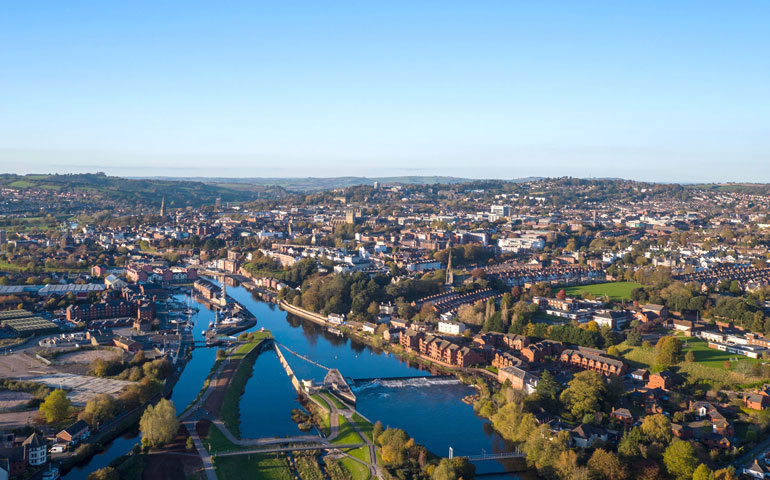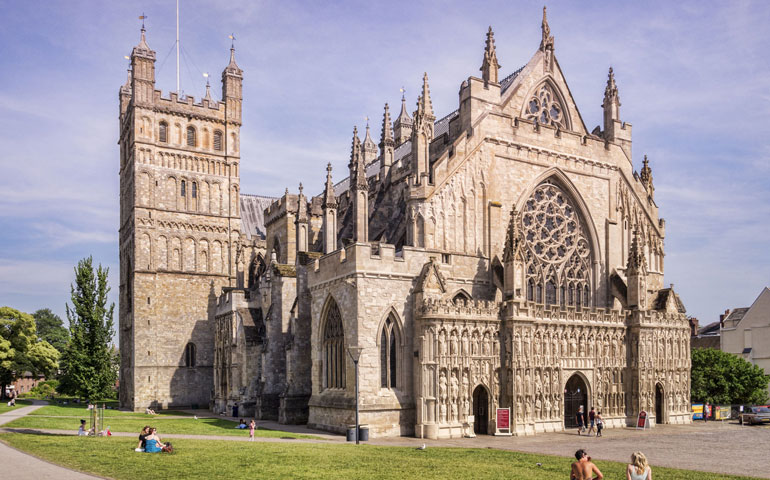As people go about their business along the A30 in Exeter, almost hidden in the grass beside them as they cross the River Exe, they cross at the same point as Roman soldiers once stomped across 2000 years ago. At that time the Exe was much wider and shallower and was easily forded. It is also likely that the built a wooden bridge for use when the river was high.
In the year 55, the Romans made Exeter one of their most important bases, as they tried to subdue the Celts to the west. They needed the tin and other metals from the rocks of this part of England, but had to protect the area with a fort. They chose the fort to be on the east - defensible - side of where they could cross the River Exe, and they called it Isca Dumnoniorum (the fort on the banks of the river Uisc among the Celtic tribe called the Dumnonii). In the second century the Romans did away with their fortress and built a wall around the town that had grown up nearby. About three quarters of this wall still survives.
Some 300 years later the Romans left England, and the Celtic people who had lived under the rule of the Romans were left to their own defences. It is likely that this was a fairly lawless time, and no new settlements were built. Then, about 600 the Saxons arrived up the Exe and refounded Exeter, calling it Escanceaster. Later it was the base for a monastery, but its position on a navigable river close to teh sea meant that it was attacked by Danish Vikings time and time again. Nevertheless, gradually Exeter became the main town of the medieval south west. It was made the home of a bishop, and a Saxon cathedral was founded in the 11th century, just before England was taken over by William the Conqueror.
By 1068 Exeter had been taken by William's forces and a castle - Rougemont Castle (named after the red stone from which it was built) – was built into a corner of the Roman city walls to oversee the area. Then, in the 12th century Exeter was given the right to hold a market and fair.
Now all this increasing coming and going to Exeter required a permanent way across the Exe, and in about 1200 the first stone bridge was built, and it is that bridge and a tower from St Edmunds church built at the end of the bridge, that you can still see today. The bridge is made of tough, dark volcanic stone, rather than the softer red stone of the tower and much of Exeter. It is now the oldest surviving medieval arched stone bridge in England.
During this time the Saxon cathedral was rebuilt, finally being completed about 1400.
But Exeter was paying the price for being far inland, in Tudor times the rise of Plymouth was a threat to trade. So in 1564 the Exeter Ship Canal was dug - one of England's first canals.
From this time Exeter remained an important regional market town, but it was still cut off from much of England by poor roads. In fact, Exeter was too far from sources of coal (or iron) to develop into an industrial centre of any size during the Industrial Revolution. As a result, the city stagnated, something that meant, accidentally, that many of its old buildings were not replaced by industrial ones.
When, in 1844, the railway arrived, it became easy to send agricultural goods from Exeter to large markets like London, but again, few factories were built.
The main road to the west is the A30, which runs right through the centre of Exeter. As lifestyles changed in the 1960s, and more families got cars and sought holidays in Cornwall, so, every summer, Exeter became one of England's most famous bottlenecks, causing the building of the bypass and later the M5.
At the same time, the river gradually ceased to be used for business, and it has been redeveloped for pleasure uses.







